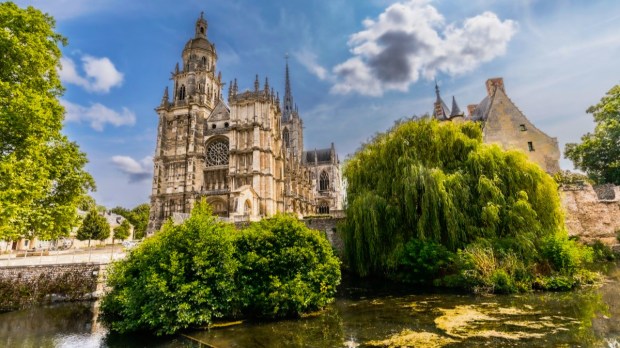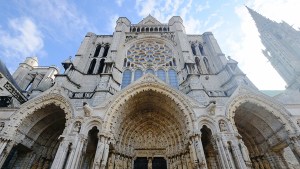Perhaps you’re familiar with the Blessed Virgin Mary’s title Queen of Heaven. Maybe you’ve sung the hymn Ave Maris Stella, which calls her Star of the Sea and Happy Gate of Heaven. You may have even sung a litany to the Blessed Virgin after Mass on one of her feast days. These litanies are full of beautiful names for Mary, like Mystical Rose and Mirror of Justice. I’ve often wondered who came up with those names and if we truly understand the depth of meaning that they contain. They’re powerful, mysterious invocations that reveal Mary’s maternal care not only for Our Lord but for all of creation.
The medieval Christians were particularly sensitive to symbolic imagery. The great cathedrals of that period, many of which are dedicated to Mary, are all built with precision and care so that the harmony of the physical dimensions, the scheme of statuary decorating both inside and outside, the location of the altar within the space, and even the way the sun shines through the windows on specific days of the year become sensible signs that the sacred space is connected to Heaven.
Cathedrals are earthly spaces that are meant to be sacred. They lift up our hearts to God. This is why many visitors in these spaces feel an overwhelming sense of divine peace when they’re inside. The space itself, in the language of beauty, invites us to worship.
The cube and the sphere
The sacredness of these Christian churches is an earthly reflection of the New Jerusalem. This is why, for instance, St. John has a vision of the New Jerusalem descending onto the earth at the end of days. His description of the heavenly city, if you look at it closely, is an odd one, essentially marking out its dimensions as a perfect cube. The cube shape is precisely the shape of the Holy of Holies in the Temple in Jerusalem, where the priest entered once per year to make sacrifice.
The cube is also a shape mimicked in many Catholic cathedrals. It can be hard to visualize, but in a cross-shaped cathedral, the area at the crux of the Cross where the nave and transepts meet is often cubical. That’s also where you can find the dome, if there is one in that particular building. The spherical shape of the dome is always connected to the cube (this pattern might also be repeated with the baldacchino, or ciborium, if there is one over the main altar). Essentially, the cube and sphere are forms belonging to a sacred architecture that squares a circle. The cube shape represents earth in its perfected form and the spherical shape is Heaven. In medieval cathedrals, the two are joined.
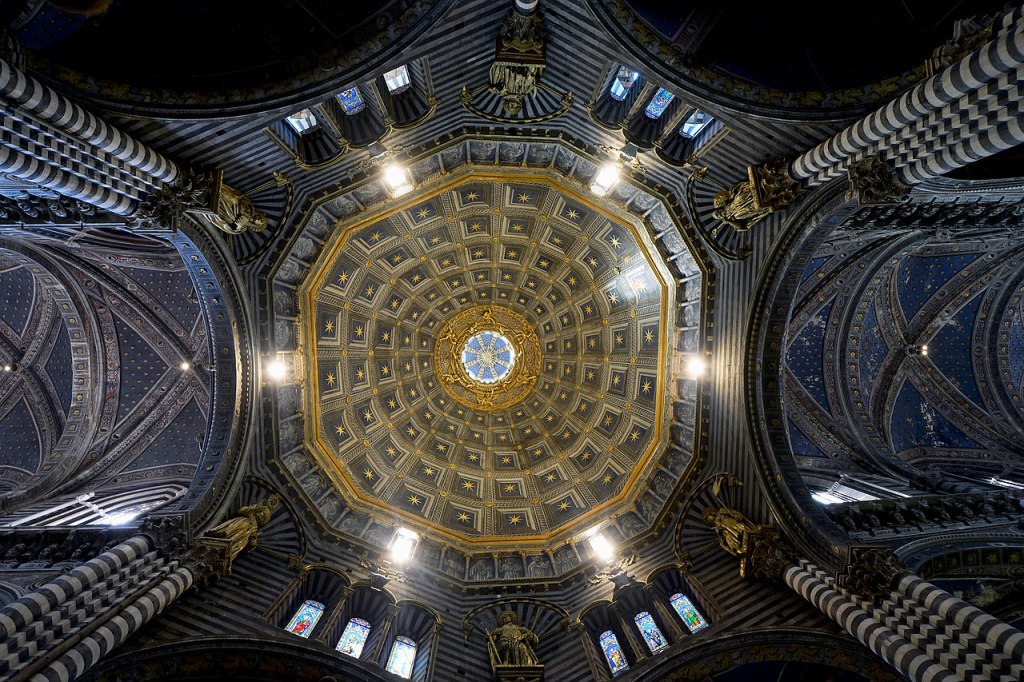
A connection to the stars
Further, the New Jerusalem that St. John sees has 12 gates representing the 12 apostles, but they also represent the 12 constellations in the zodiac. I want to be clear, here, that Christians have never used the zodiac for astrological purposes, but they, like every other ancient person, knew the constellations of the zodiac for astronomical purposes. They used the progress of the constellations through the sky to mark out the calendar year. This is why 12 is such a special number. It marks out the fullness of the solar cycle.
The connection of the number 12 with the stars in the sky becomes clear when we observe that many cathedrals have ceilings painted dark blue, punctuated by golden stars. This is another clue that the Catholic cathedral is a symbolic, perfected version of the cosmos. For instance, in the seminary chapel in St. Louis where I live, the ceiling is a starry night sky. I remember looking up at that painted sky during Mass when I was there. I was literally lifting up my eyes to Heaven, an action that I found particularly helpful in focusing my prayer.
Mary herself is often depicted in artwork wearing a blue cape. In some apparitions, such as at Guadalupe, the cape she wears literally has stars on it. It’s hard to see that cape and fail to think of her as Queen of Heaven. During those same apparitions, she gently insists that she is also our Mother the Church. Her cape of stars and the star-studded ceilings of cathedrals are related. The motherhood of Mary takes on cosmic dimensions.
The Mystery of the Black Virgin
Recently, I was reading Jean Hani’s bookThe Black Virgin: A Marian Mystery, which is now back in print thanks to Angelico Press.
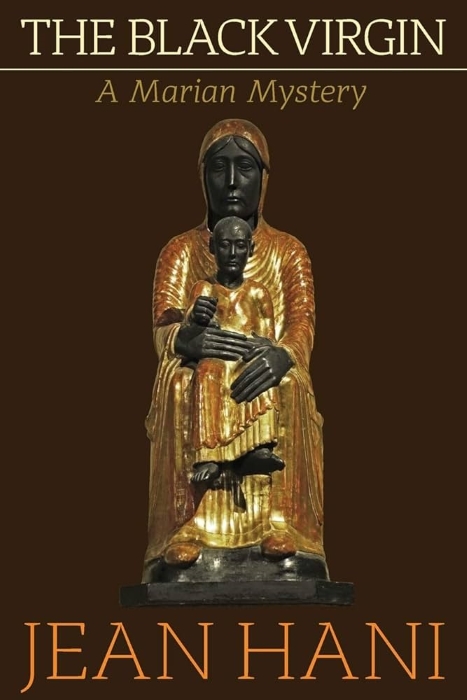
In it, Hani makes an even more fascinating connection between Mary and the stars. He writes, “The great cathedrals, all dedicated to Our Lady, that were built in the 12th and 13th centuries in northern France – in Champagne, Picardie, Ile-de-France, and old Neustria – are situated in such a way as to reproduce almost exactly the constellation of the Virgin on the ground.” He’s speaking here of the constellation Virgo, which he notes rises in the eastern sky in March, right around the feast of the Annunciation, and sets in the west in September around the feast of the Nativity of the Blessed Virgin.
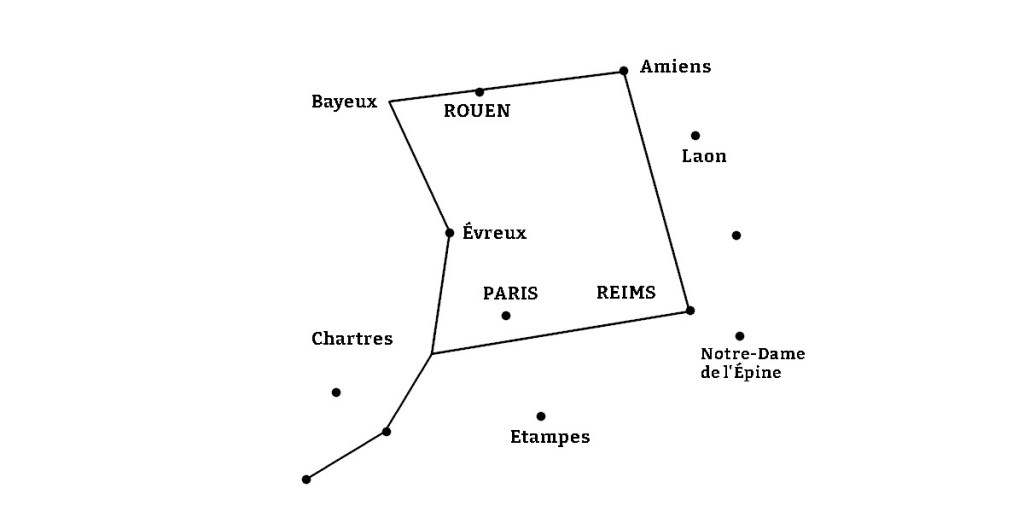
He further notes that some of the famous Gothic cathedrals, the ones that still attract crowds of tourists to this day, are all dedicated to the Virgin and represent specific stars that within the constellation; “The star Spica is at Reims, Gamma at Chartres, Delta at Amiens, and Epsilon at Bayeux.” Some of the smaller stars correspond to churches in, “Evreux, Etampes, Laon and Notre-Dame de l’Epine.”
The fact that the medievals were able to embark on a centuries-long building program across a wide geographical area in which they placed churches precisely into a map of the sky leaves me in awe.
Everything knit together
“This should not astonish us,” says Hani. Christians at the time had a sophisticated knowledge of astronomy, the sky was extremely important to them in telling time and seasons, and many of the great celebrations of the Church calendar are attached to astronomical events, particularly ones that are connected to sowing and harvesting in the fields. Everything in creation is knit together. All things speak of God’s tender care and love as the Creator.
Hani calls it a heavenly map that reveals the sympathy of the cosmos with its Creator. Through the language of architecture, and astronomy, and geometry, we are able to not only think about God in the abstract – we are able to create a beautiful home for him that anticipates our arrival in the New Jerusalem.
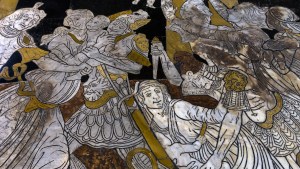
erwrwerwerew
